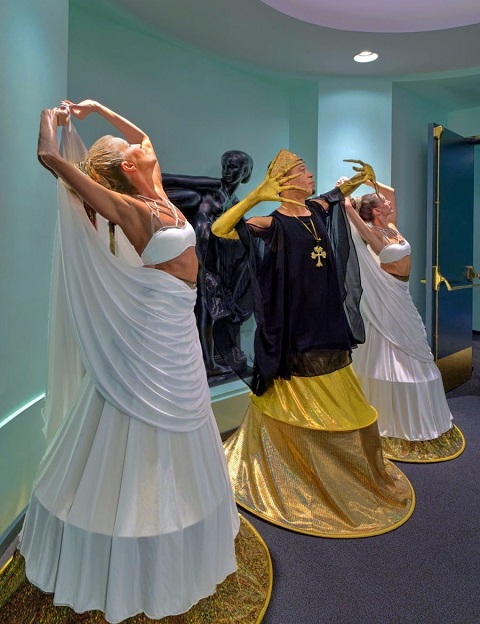The Armenian Mirror-Spectator. (Editor’s Note: This review from fall 2019 preview is reprinted now to announce two January 2021 on-line events. As an official selection of the Ridgewood Guild International (Virtual) Film Festival, the show’s 90-minute documentary LIVE performance film will be screened and discussed (January 27 – 31). On January 23 The Lied Society will devote an hour-long interview with Ekizian among experts of the arts.)
NEWARK, N.J. — “Gorky’s Dream Garden,” a new work by composer Michelle Ekizian that hybridizes classical opera with popular Broadway musical theater, sacred Armenian litanies with jitterbugging, would give delight to both Stravinsky and George Gershwin and would lead her Armenian precursor Aram Khachaturian to do a sabre dance. Within her will to break boundaries is a parable: the defiance of the negativity surrounding the goal to dream bigger dreams. Ekizian’s musical dream was inspired by Arshile Gorky, the great Armenian-American artist and a founding father of abstract expressionism, whose life’s story is loosely told in her daring new music theater opera. This reach beyond was realized in the September 7, 2019 presentation at the Newark Museum of Art’s Billy Johnson Theater of the work’s developmental reading of its Love Songs Showscape in chamber concert.
Working through traumas imposed by the Armenian Genocide and subsequent personal tragedies, Gorky rose above his tribulations by creating art in a boundary breaking style through which realism, surrealism and abstraction collided and colluded. With the opera’s rapturous music, we find the artist embarking on a thought-provoking journey to a place where nothing seems impossible — and where his search for the beautiful and the eternal begins.
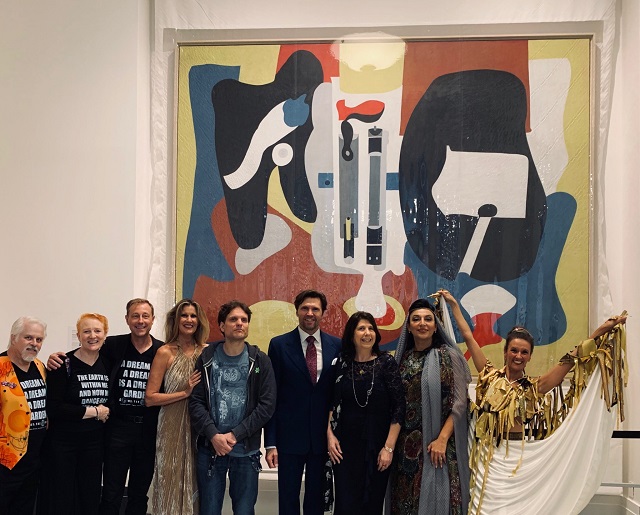
Before Arshile Gorky’s mural panel Mechanics of Flying at Newark Museum: some of the performers of Love Songs Showscape with composer Michelle Ekizian (3rd from right), leading man Brent Barrett (center) and artist Vahakn Arslanian to his left, plus: members of Art of Motion Dance Theatre and mezzo, Hasmik Mekanedjian.. Palisades Virtuosi 1-3 from left in Dream Tees designed by Ekizian. Photo: Tony Mark
Read also
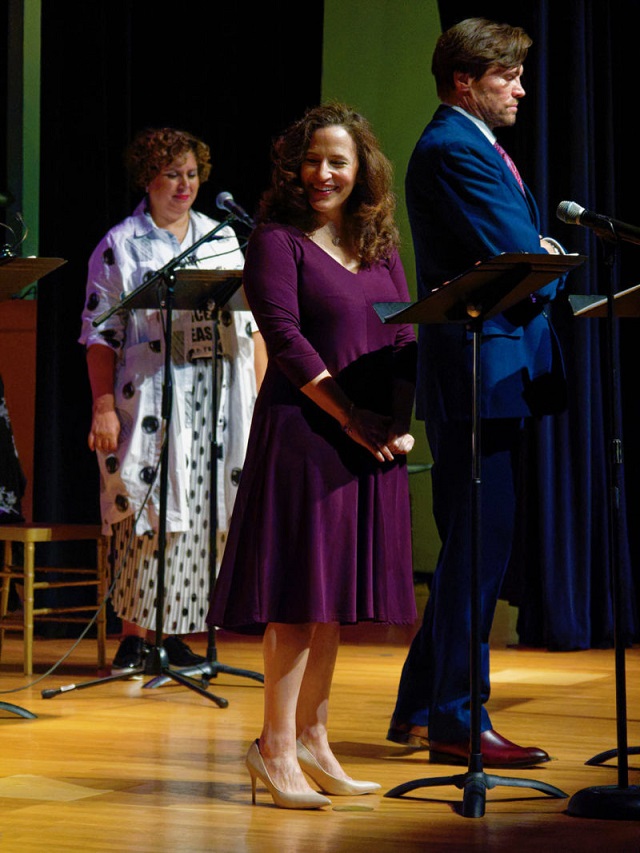
Brent Barrett (center) as the artist Arshile Gorky with soprano Karen Lubeck and actor Adela Maria Bolet portraying mid-century modern American life. Photo: Hank Gans
Charged with contemporary immediacy, crossing of shifting time zones (real and dream time), pivotal points of stasis and differing points of view, “Gorky’s Dream Garden” approaches the intensified continuity of cinema. Its dazzling music hails from Ekizian’s opulent symphonic orchestration — shining forth in the Showscape’s virtuoso chamber rendition. The score melds, old Armenian hymns, folk tunes and lullabies, jitterbugging monologues, exhilarating Russian style waltzes, Neapolitan love song, bel canto, power ballads, and a rhythm section of electric guitars and drum set. Broadway veteran, bari-tenor/actor Brent Barrett portrayed the complicated artist with a captivating soulful affinity. Traversing the role’s wide range of singing styles, he gave the necessary exotic Russian/Armenian imperious stance while also exuding suave and sultry charisma. But he held steadfast to Gorky’s grace and his creative rigor with wonder and innocence. The perfect foils for the mysterious “phantom of the opera” mystique of Gorky are the roles of the ghost spirit of his courageous martyred mother and his capricious ingénue American bride.
Mezzo-soprano Hasmik Mekanedjian and soprano Karen Lubeck were naturals.
In quick cutting dialogue over music, the Art Whisperers acting duo portrayed Gorky’s friends, supporters, critics and foes including art world luminaries and Mayor Fiorello LaGuardia. New York actors Adela Maria Bolet and John Sannuto performed their multiple roles with the necessary satire and high voltage.
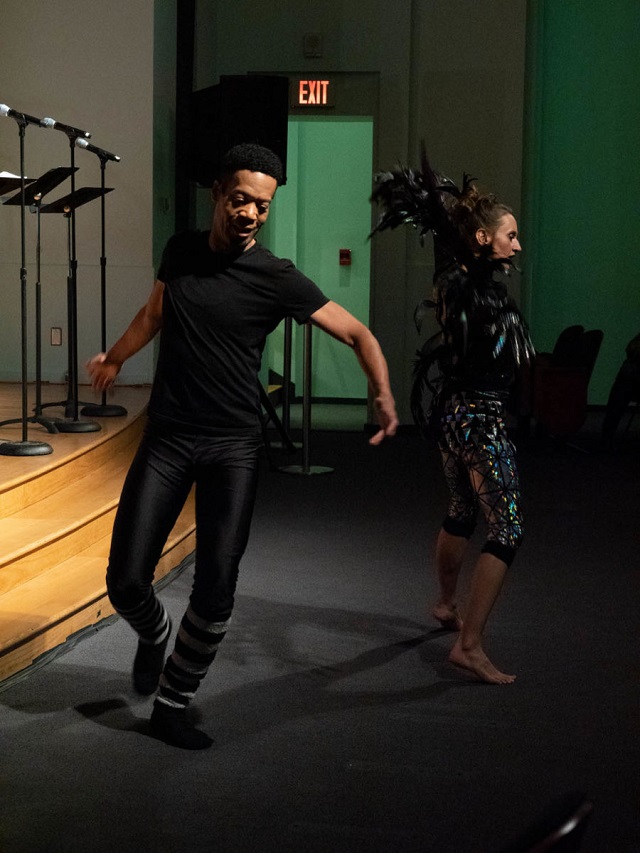
Nighttime enigmas of the artist’s lost Armenian lands with dancers Marcos Velazquez & Dishuk as the young artist and his mother (left), and Taylor & Dishuk as the Black Monk and a Eurasian blackbird. Photo Hank Gans
For the speaking role of Gorky’s empathetic and eccentric sister Vartoosh, Bolet delivered tender reminiscences and letter readings with heartbreaking effect.
Traversing the artist’s final years (from 1939 to his death at age 44 in 1948), the story opens at the Aviation Pavilion of the 1939 World’s Fair where Gorky designed its aviation murals. The mellifluous playing of the Palisades Virtuosi (flute, clarinet and piano) brought a cool, airborne sonority in tune with the flight theme of Gorky’s Aviation Murals—and the ancient Armenian wind instrument, the “duduk.” In the Showscape’s Prequel we meet the tall, dark and handsome thirty-something bachelor in the Big Apple during the 1930s in search of romance amidst a fashion show featuring his girlfriends, charmingly performed by the dancers.
Following, the artist’s story of exile, immigration and assimilation eventually shows him married with children, living in a modernist Glass House in the suburbs of Connecticut, achieving a slice of the American dream…until misfortunate events kindle his escalating nostalgic and tormented memories of his lost homeland.
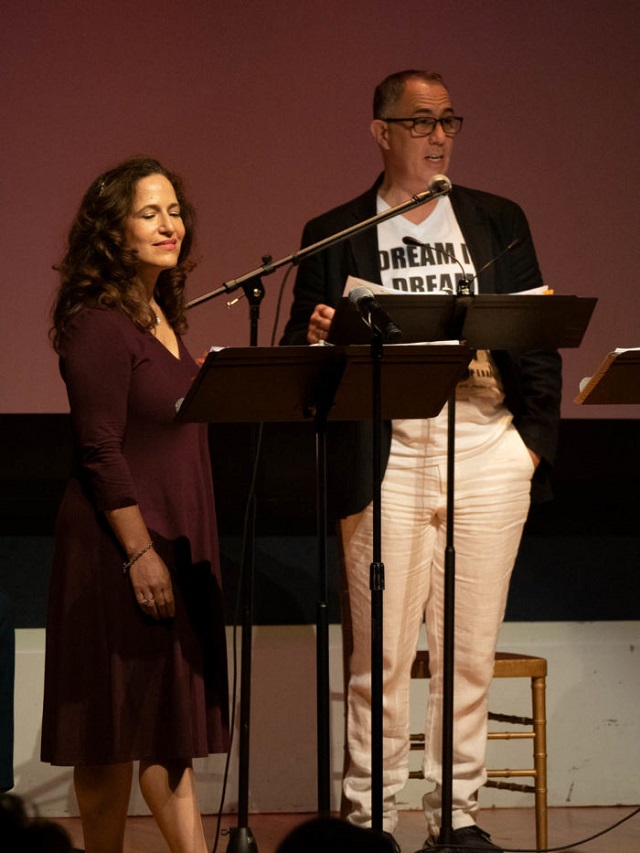
Bolet as the artist’s sister Vartoosh in flash-forward to 1981 reads a letter from her brother and reminisces about their childhood lakeside village. Dancer Needle as the mute white swan of Lake Van recreates their martyred mother. Soprano Lubeck as Agnes and actor Sannuto as Gorky’s colleague Roberto Matta find romance. Photo Hank Gans
Ekizian’s gripping psychodrama captures the essence of the artist to the point that his specters are not just demons, but a sacred gift for a means to rise beyond. Through his art, Gorky transformed his hidden crosses that marked both the horrors of genocide and his nostalgia for his ancestral lands of Eden and Ararat into color and light. For the artist’s closure at the opera’s grand finale rather than dwelling on his suicide, Ekizian chose spirit and harmony to focus on our own unity as expressed through the ecstasy of music. Developed through concert works inspired by the Interfaith Committee of Remembrance at New York City’s Cathedral of St. John the Divine on behalf of victims of the Armenian Genocide and The Holocaust, the work awakens compassion.
Summoning emotions and fantasies implied by Gorky’s heartbreaking portraits and his groundbreaking biomorphic abstractions, the music is filled with floating, gliding and soaring sensations. With a surrealist twist, the protagonist’s dreams running alongside the story’s real time come to life in dance episodes such as “Van Lake” (the region of Gorky’s birth), and “Dance of the Apricot Girls” (after Armenia’s definitive fruit). Using the theater’s entire foot print, the superb quartet of dancers from the Art of Motion Dance Theatre — Lynn Needle (choreographer/director), Janette Dishuk (dance captain), Marcos Velasquez and M. A. Taylor—performed in posed tableaux, en pointe, and in modern and street dance styles. In stunning costumes designed by Annie Hickman, and some by the composer, they immersed the audience with fantastic esprit.
Appearing to rise from the ashes, the Showscapes’s penultimate song counterpointed the protagonist’s down hill dive in the real world with his uphill spiritual path in his dream garden.
For the Newark performance of this song, the dancers (with mezzo Mekanedjian in movement only) in Needle’s riveting “Dance of the Exiled Heart” performed before the composer’s music video montage featuring images of the genocide transitioning to glorious panoramas of Gorky’s lost Armenian lands. On the video in the cameo role of the Black Monk was heard the voice of the legendary late “Woodstock/Freedom” folksinger Richie Havens eventually leading to an epiphany moment. Ekizian’s selection for leading man Barrett to return to the stage to sing Gorky’s intimate “In Dreams” from ACT III, as the Showscape’s Postscript was a brilliant touch. The song — like Ekizian’s epic music and Gorky’s courageous art — defied dwelling on old enemies and life’s misfortunes as a means to define the protagonist. This universal outreach was reinforced in the Newark preview’s pop-up interactive spectacle at the museum’s Welcome Center. “Wishing Tree with Birds” by the visual artist Vahakn Arslanian invited passersby to offer their own inscriptions for a better world. It was a perfect counterpart to the Showscape: through Gorky’s dream garden, Ekizian’s masterpiece invites its listeners to dream of a dream garden for our own troubled time.
Main caption: Dream scenes of “Gorky’s Dream Garden” featuring Mother, World and Holy Breath performed by dancers Lynn Needle, M.A. Taylor, Janette Dishuk. Photo: Hank Gans




















































